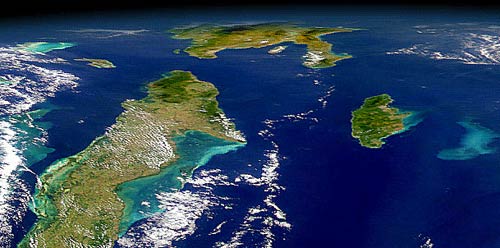The Bahamas: Sea Level Rise
Sea Level Rise - Short Introduction:

As a result of global warming, the penetration of heat into the ocean leads to the thermal expansion of the water; this effect, coupled with the melting of glaciers and ice sheets, results in a rise in sea level. Sea-level rise will not be uniform globally but will vary with factors such as currents, winds, and tides as well as with different rates of warming, the efficiency of ocean circulation, and regional and local atmospheric (e.g., tectonic and pressure) effects.
Many islands and atolls in the Pacific and Indian Oceans rarely exceed 3 - 4 m above mean sea level in elevation and therefore they could be vulnerable to changes of this magnitude.
That already happened:
Global sea level has risen by between 10 and 25 cm over the past 100 years and much of the rise may be related to the increase in global mean temperature.
Future consequences of climate change:
Computer simulations project, that the global mean sea level will rise by 15 - 95 cm by 2100 (with a "best estimate" of 50 cm).
Possible consequences of Sea Level Rise:

Major coastal impacts will result from accelerated sea-level rise; these effects will include coastal erosions, saline intrusion, and sea flooding, among other impacts.
Human Settlements and Infrastructure: In a number of islands, vital infrastructure and major concentrations of settlements are likely to be at risk, given their location at or near present sea level and their proximity to the coast (often within 1-2 km; e.g., Kiribati, Tuvalu, the Maldives, the Bahamas). Moreover, vulnerability assessments also suggest that shore and infra-structure protection costs could be financially burdensome for some small island states.
For other consequences see:
The Bahamas - Tourism
Further informations:
 As a result of global warming, the penetration of heat into the ocean leads to the thermal expansion of the water; this effect, coupled with the melting of glaciers and ice sheets, results in a rise in sea level. Sea-level rise will not be uniform globally but will vary with factors such as currents, winds, and tides as well as with different rates of warming, the efficiency of ocean circulation, and regional and local atmospheric (e.g., tectonic and pressure) effects.
As a result of global warming, the penetration of heat into the ocean leads to the thermal expansion of the water; this effect, coupled with the melting of glaciers and ice sheets, results in a rise in sea level. Sea-level rise will not be uniform globally but will vary with factors such as currents, winds, and tides as well as with different rates of warming, the efficiency of ocean circulation, and regional and local atmospheric (e.g., tectonic and pressure) effects. Major coastal impacts will result from accelerated sea-level rise; these effects will include coastal erosions, saline intrusion, and sea flooding, among other impacts.
Major coastal impacts will result from accelerated sea-level rise; these effects will include coastal erosions, saline intrusion, and sea flooding, among other impacts.